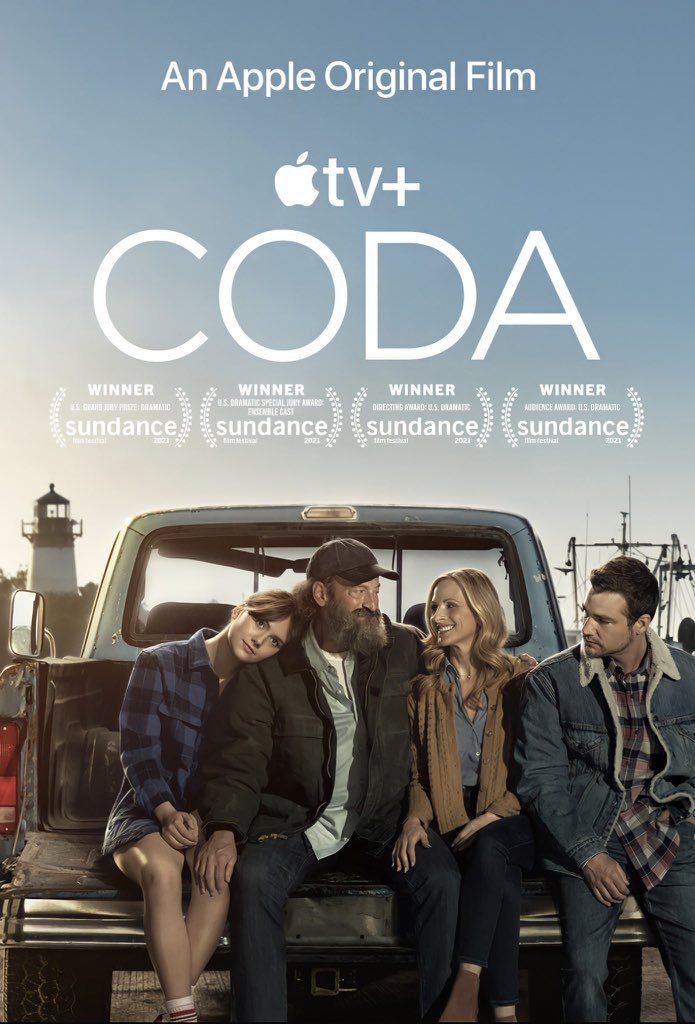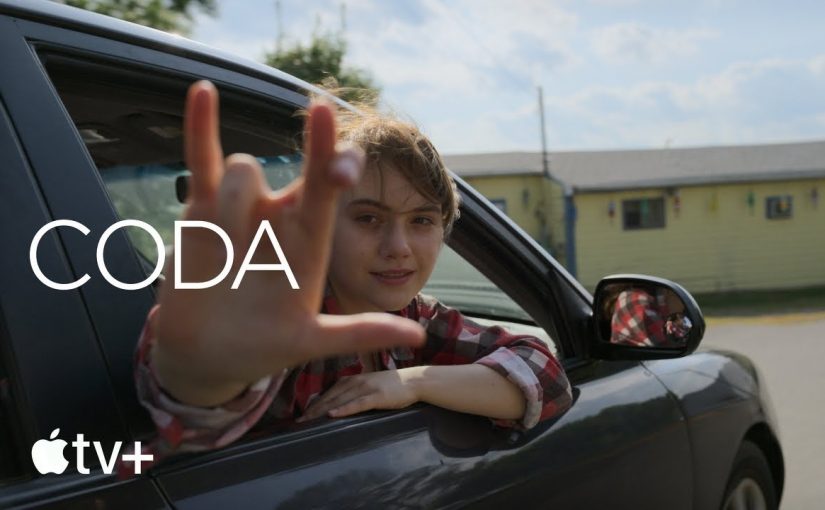I FINALLY watched “CODA,” the film that swept the Sundance Film Festival and is now on Apple+. Despite its rave reviews, I was nervous to watch because of how it might portray deafness. As someone who was raised to lipread and speak (and isn’t an exception), I’m sensitive to the pervasive assumption that all deaf people sign.
But like many other things, deafness is a spectrum. And this film shows one part of it, in a beautiful way. Thankfully, it doesn’t present an idealized version of Deaf Culture, and there was a lot I could relate to. It’s a well done, lovely film.

The Beginning Set the Tone
As soon as the film began, I knew it would be different. The first sign was when my (hearing) husband Aaron told me that the ambient sounds were very clear. He said there was a lot of work and effort put in to make the audio landscape a rich sound experience. This level of effort isn’t typically done. As Aaron said, “I know why they did it. They’re trying to accentuate to a hearing audience, to remind us that it’s about all those sounds out there in the world.”
The second sign was when the first song came on. The captions told me the name of the song, the musician(s), how it was being played, AND the lyrics – and continued to do so throughout the movie. This rarely happens. In fact, most of the time, song lyrics don’t appear at all. This is a huge pet peeve. Why would you caption a film but not the entirety of it? Why would you censor a feature that actually adds MORE to the experience?
Relatable Scenes for Me
The first time we meet Ruby’s deaf parents, they pull up in their truck outside her school with the music blaring. Ruby’s embarrassed because everyone is watching. Her dad signs, “I love rap music; my whole ass is vibrating!” Ruby’s parents and brother don’t wear hearing aids or cochlear implants (it’s unknown whether they choose not to or if they just don’t help with their kind of hearing loss), so they need the music at a high volume to be able to feel it. Bass and defined beats help.
Because I have a cochlear implant and hearing aid, I don’t need things at a loud volume. I can tell if something’s high or low, but not the specific pitch. Forget melodies or tunes. I don’t even know the difference between the two. I gravitate towards music that has defined beats and/or lyrics that can be heard over the music. There’s a reason I loved Harry Connick Jr. and the Red Hot Chili Peppers when I was in high school!
When her family attends Ruby’s concert, they’re out of their element. Jackie asks her son Leo if he can read Mr. V’s lips on stage. “Not really,” he responds. This is always the first thing I do at an event; I gauge how much I’ll be able to understand independently.
The Rossis are completely lost. They notice audience members laughing, but don’t know the joke. They don’t know to clap until they see others doing so. They’re so bored that Frank notices the buttons are off on his shirt, and they talk about Ruby’s outfit and what to have for dinner.
This is exactly how I am at my kids’ concerts (and other events when I can’t follow or enjoy the proceedings). Sometimes I go to support them, even if it feels like torture to sit there, bored and missing out. I always wish I could discreetly read on my phone, but I don’t want other people thinking I’m rude. Sometimes I deal with this by only attending the “more important” concerts, like my daughter’s last high school orchestra concert. Thankfully, my family understands!
I also enlist my hearing companions to be my ears. Aaron and I now have a shorthand; he knows when I’m asking, “Are they good?” or “Does she have a good voice?”
At one point, the sound fades out during Ruby’s duet to illustrate what it’s like for the Rossis. This normally cliched trick is usually heavy handed. But in this case, it’s effective. It’s not indicative of my experience, since I wear hearing devices, but it’s representative, if that makes sense. I hear music, but can’t appreciate it in the way hearing people can. The Rossis observe their fellow audience members and their wide range of experiences; this is one thing I do to amuse myself as well.
Aaron pointed out that the songs chosen for the movie were done purposefully. He thinks they picked songs for which the original singers conveyed their emotion and presence. The songs have a lot of soul in them, and further emphasizes the contrast between the audience and family experience.
Relatable Scenes for Hearing Family Members
I wasn’t the only one who could relate to many scenes. Aaron said the parenting stuff hit; that’s universal.
“The really noisy kitchen table scene when she’s trying to study and they’re all making a lot of noise… YEAH!” my husband said. “There’s a reason why a lot of our plates have chipped bottoms, because you put them down hard. You are not the quietest person in the kitchen, that’s for sure!”
Ruby is her family’s de facto interpreter, and we both noticed she paraphrases. Aaron has seen our kids do this, and has done it himself, like when someone on the phone is rambling. As he pointed out, however, Ruby was paraphrasing in ways that showed she was getting frustrated. When he does it, it’s for efficiency. “But I’m not a teenager!” he added.
I do try to utilize my kids as interpreters as little as possible, and I would never put them in the situations portrayed in the movie. They usually voluntarily step up when they notice I’m missing out. One difference is interpreting for me is different than for the Rossis. When my family interprets, it’s English to English, which isn’t the same as English to ASL.
Unrealistic/Unrelatable Scenes
Being the only hearing person in her family is difficult for Ruby. She has to interpret for them with no thought to her own schedule or desires. Alarmingly, she interprets for her parents at a doctor’s appointment in which sensitive information is revealed, and at a Coast Guard legal proceeding.
In real life, these situations legally warrant an interpreter, whether in person or remote. Having a child interpret these is wrong for so many reasons. The Coast Guard knew the Rossis were deaf; it’s why they were there in the first place. The lack of accommodation violates the ADA and should never happen.
There’s a touching scene between Jackie and Ruby, when Ruby asks her mom if she ever wished that Ruby was deaf. Jackie admits she prayed that her daughter would be deaf, though she says it’s because she was worried they wouldn’t connect. Deaf Culture folks actually want their kids to be deaf, and this is only one reason. I’m the opposite. I prayed that my kids would be hearing. Isn’t it our job as parents to ensure that our kids’ lives are easier and better than ours? Granted, it’s a little different in the capital-D Deaf Community, because there’s literally a communication barrier.
I was shocked that Ruby never provided her parents with printed lyrics to the songs sung at the concert and in her audition. Or that they didn’t use their phones to look up the lyrics based on the songs listed in the program. I kept waiting for Ruby to sign and sing as a way to include her family!
Communication Difficulties
Ruby’s family is dependent on her because they communicate via ASL. The film did a good job of showing how difficult this method can be. Frank, Jackie, and Leo miss out socially and professionally. These examples are exactly why I’m thankful my parents made the choice they did. You can always learn how to sign later in life, but you can’t always learn how to lipread, hear, and talk if you miss the early language development window.
Humor and Heart
The movie’s humor is evident early on and provides a nice break from the heavy topics. There are lots of laugh out loud moments, like when Frank demonstrates the need for putting a helmet on a soldier. That’s one way in which the visual of sign language is much more effective!
The scene between Frank and Ruby after her concert brought tears to my eyes, despite myself. It’s that age old trope of a parent trying to understand their child, but with a twist.
The movie is about Ruby realizing what her dreams are and having to choose between that and helping her family. In actuality, Ruby and her deaf family members help each other. She pushes them outside of their bubble and forces them to think about relying on others. She stands up for herself and her bravery allows them to do the same.
Today’s generation of deaf kids with cochlear implants – and hearing kids of deaf parents who speak, for that matter – can’t really relate to the Rossis’ struggles. And that’s a good thing. My children are CODAs, but not in the way the definition is traditionally used.
I went in expecting the worst, that it would amplify deaf stereotypes in the media. Instead, it was a nuanced portrayal that still captured realistic parts of the deaf experience. I’m glad I watched.

We loved your review and how you wrote it!
Thank you!! xoxo
Loved this review. I’m glad I watched too!!!
Thank you!